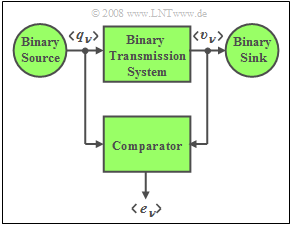Difference between revisions of "Aufgaben:Exercise 3.7: Bit Error Rate (BER)"
| Line 27: | Line 27: | ||
$\rm (B)$ On the other hand, for the metrological determination of the transmission quality or for the system simulation, it is necessary to rely on | $\rm (B)$ On the other hand, for the metrological determination of the transmission quality or for the system simulation, it is necessary to rely on | ||
| − | :the comparable ''A-posteriori parameter'' '''Bit | + | :the comparable ''A-posteriori parameter'' '''Bit Error Rate''' must be ignored. |
::$$h_{\rm B}=\frac{n_{\rm B}}{N}=\frac{\rm 1}{\it N}\cdot\sum\limits_{\it \nu=\rm 1}^{\it N} e_{\nu}.$$ | ::$$h_{\rm B}=\frac{n_{\rm B}}{N}=\frac{\rm 1}{\it N}\cdot\sum\limits_{\it \nu=\rm 1}^{\it N} e_{\nu}.$$ | ||
| Line 65: | Line 65: | ||
| − | {How large; is the | + | {How large; is the rms of the random variable $n_{\rm B}$ for $p_{\rm B} = 10^{-3}$ and $N = 10^{5}$? |
|type="{}"} | |type="{}"} | ||
$\sigma_{n{\rm B}} \ = \ $ { 10 3% } | $\sigma_{n{\rm B}} \ = \ $ { 10 3% } | ||
| Line 92: | Line 92: | ||
| − | {It still holds $p_{\rm B} = 10^{-3}$ and $p_\varepsilon = 95\%$. | + | {It still holds $p_{\rm B} = 10^{-3}$ and $p_\varepsilon = 95\%$. Over how many symbols $(N_\text{min})$ must be averaged at least, <br>so that the determined bit error rate in the range between $0. 9 \cdot 10^{-3}$ and $1.1 \cdot 10^{-3}$ lies $(\varepsilon = 10^{-4}, \ \text{10% of nominal value)}$ ? |
|type="{}"} | |type="{}"} | ||
$N_\text{min} \ = \ ${ 400000 3% } | $N_\text{min} \ = \ ${ 400000 3% } | ||
Revision as of 21:37, 3 January 2022
We consider a binary transmission system with.
- the source symbol sequence $\langle q_\nu \rangle $ and
- the sink symbol sequence $\langle v_\nu \rangle $.
If sink symbol $v_\nu$ and source symbol $q_\nu$ do not match, there is a bit error ⇒ $e_\nu = 1$.
Otherwise $e_\nu = 0$ holds.
$\rm (A)$ The most important evaluation criterion of such a digital system is
- the Bit Error Probability .
- With the expected value ${\rm E}\big[\text{ ...} \big]$ this is defined as follows:
- $$\it p_{\rm B} = \rm E\big[\rm Pr(\it v_{\nu} \ne q_{\nu} \rm )\big]=\rm E\big[\rm Pr(\it e_{\nu}=\rm 1)\big]=\lim_{{\it N}\to\infty}\frac{\rm 1}{\it N}\cdot\sum\limits_{\it \nu=\rm 1}^{\it N}\rm Pr(\it e_{\nu}=\rm 1). $$
- The right part of this equation describes a time averaging; this must always be applied, for example, to time-varying channels.
- If the error probability is the same for all symbols (which is assumed here), the above equation can be simplified:
- $$\it p_{\rm B} = \rm E\big[\rm Pr(\it e_{\nu}=\rm 1)\big]=\rm E\big[\it e_{\nu} \rm \big].$$
- The bit error probability is an a priori parameter, so it allows a prediction for the expected result.
$\rm (B)$ On the other hand, for the metrological determination of the transmission quality or for the system simulation, it is necessary to rely on
- the comparable A-posteriori parameter Bit Error Rate must be ignored.
- $$h_{\rm B}=\frac{n_{\rm B}}{N}=\frac{\rm 1}{\it N}\cdot\sum\limits_{\it \nu=\rm 1}^{\it N} e_{\nu}.$$
- $h_{\rm B}$ is a relative frequency. $n_{\rm B}$ indicates the number of bit errors occurred when a total of $N$ symbols (bits) transmitted.
- In the limiting case $N \to \infty$ the relative frequency $h_{\rm B}$ coincides with the probability $p_{\rm B}$ .
- Here now the question shall be clarified, which statistical uncertainty has to be expected with finite $N$ .
Hints:
- The exercise belongs to the chapter Gaussian random variables.
- Read the exercises as far as possible in general.
- Use the parameter values $p_{\rm B} = 10^{-3}$ and $N = 10^{5}$ for control input.
- The following are some values of the so-called Q-function:
- $$\rm Q(\rm 1.00)=\rm 0.159,\hspace{0.5cm}\rm Q(\rm 1.65)=\rm 0.050,\hspace{0.5cm}\rm Q(\rm 1.96)=\rm 0.025,\hspace{0.5cm}\rm Q(\rm 2.59)=\rm 0.005.$$
Questions
Solution
- Relative to the random variable $n_{\rm B}$ there is the classical case of a binomial distribution.
- The sum over $N$ binary random variables is formed.
- The possible values of $n_{\rm B}$ thus lie between $0$ and $N$.
- The linear mean gives $m_{n{\rm B}}=p_{\rm B}\cdot N=\rm 10^{-3}\cdot 10^{5}=\rm 100.$
(2) Für the rms of the binomial distribution holds with good approximation:
- $$\sigma_{n{\rm B}}=\sqrt{N\cdot p_{\rm B}\cdot (\rm 1- \it p_{\rm B}{\rm )}} \hspace{0.15cm}\underline{\approx 10}.$$
(3) Possible values of $h_{\rm B}$ are all integer multiples of $1/N$. These all lie between $0$ and $1$.
- For the mean value, one obtains:
- $$m_{h{\rm B}}=m_{n{\rm B}}/N=p_{\rm B} = 10^{-3}.$$
- The scatter results in
- $$\sigma_{h{\rm B}}=\frac{\sigma_{n{\rm B}}{N}=\sqrt{\frac{ p_{\rm B}\cdot (\rm 1- \it p_{\rm B}{\rm )}}{N}}\hspace{0.15cm}\underline{\approx \rm 0.0001}.$$
(4) Correct is the first proposition. It holds:
- $${\rm Pr}(h_{\rm B} > p_{\rm B} + \varepsilon)=\rm Q({\it\varepsilon}/{\it\sigma_{h{\rm B}}),$$
- $$\rm Pr(\it h_{\rm B} < p_{\rm B} - \itvarepsilon {\rm )}=\rm Q(\it{\varepsilon}/{\sigma_{h{\rm B}}{\rm )}$$
- $$\Rightarrow \hspace{0.5cm}\rm Pr(\it |h_{\rm B} - p_{\rm B}| \le \varepsilon \rm )=\rm 1-\rm 2\cdot \rm Q({\it \varepsilon}/{\it \sigma_{h{\rm B}}).$$
(5) One obtains with the numerical values $\varepsilon = \sigma_{h{\rm B}} = 10^{-4}$:
- $$p_{\varepsilon}=\rm 1-\rm 2\cdot \rm Q(\frac{\rm 10^{\rm -4}}{\rm 10^{\rm -4}} {\rm )}=\rm 1-\rm 2\cdot\rm Q(\rm 1)\hspace{0.15cm}\underline{\approx\rm 0.684}.$$
In words:
- If one determines the bit error rate by simulation over $10^5$ symbols,
- with a confidence level of $\underline{68.4\%}$ one obtains a value between $0.9 \cdot 10^{-3}$ and $1.1 \cdot 10^{-3}$,
- if $p_{\rm B} = 10^{-3}$ is.
(6) From the relation $p_{\varepsilon}=\rm 1-\rm 2\cdot {\rm Q}(\alpha) = 0.95$ it follows directly:
- $$\alpha_{\rm min}=\rm Q^{\rm -1}\Big(\frac{\rm 1-\it p_{\varepsilon}}{\rm 2}\Big)=\rm Q^{\rm -1}(\rm 0.025)\hspace{0.15cm}\underline{=\rm 1.96}\hspace{0.15cm}{\approx\rm 2}.$$
(7) It must $\alpha = \varepsilon/\sigma_{h{\rm B}}$ With the result of the subtask (2) then follows:
- $$\frac{\varepsilon}{\sqrt{p_{\rm B}\cdot(\rm 1-\it p_{\rm B})/N}}\ge {\rm 2} \hspace{0.5cm}\Rightarrow\hspace{0.5cm} N\ge \frac{\rm 4\cdot \it p_{\rm B}\cdot(\rm 1-\it p_{\rm B})}{\varepsilon^{\rm 2}}\approx \frac{\rm 4\cdot 10^{-3}}{10^{-8}}\hspace{0.15cm}\underline{=\rm 400\hspace{0.08cm}000}.$$
